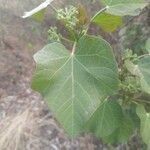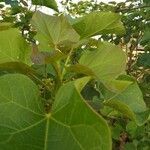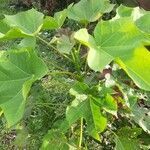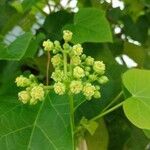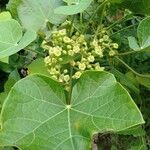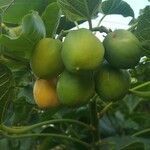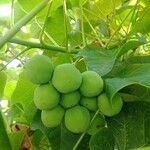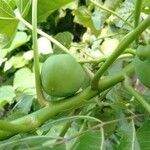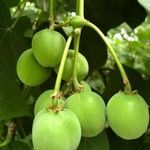Shrub or small tree ca (1-) 2-5 m high; branches and mature foliage glabrous. Leaves with petioles (3-)9-15 cm long; stipules nearly obsolete, not evident on mature leaves; blades ovate, unlobed or coarsely (3-)5-7-lobed (lobes extending less than halfway to midrib), palmatinerved with mostly 7 nerves and deeply or broadly cordate at base, mostly 10-25 cm long, 9-15 cm broad, sparsely puberulent when young but soon glabrescent. Dichasia terminal on branches, bisexual or often unisexual; axes tomentulose, glabrescent, becoming ca 10-25 cm long; peduncles mostly 4-10 cm long; lower bracts narrowly lanceolate, 2-15 mm long, entire (not glandular). Staminate flowers with puberulent pedicels, ca 1-5 mm long, articu-lated below the flowers; calyx-lobes 5, elliptic, blunt, entire (not glandular), scarcely imbricate, ca 2.8-3.5 mm long; petals obovate, greenish or yellowish-white, adaxially hirsute, ca 5-6 mm long; disc-segments 5, ellipsoid, erect, massive, ca 1 mm high; stamens (8-) 10, the filaments 2.2-3.7 mm long, connate below the middle, the anthers elliptic, 1-1.6 mm long; pistillode absent. Pistillate flowers with pedicels 5-9 mm long, up to 10-13 mm long in fruit, glabrous; calyx-lobes 5, oblong to lanceolate, foliaceous, obtuse or subacute at tip, entire, becoming ca 7-9 mm long; petals similar to the staminate; ovary glabrous, the styles slender, ca 1.5 mm long, connate in lower half, dilated into massive stigmata. Capsules ellipsoidal, ca 3 cm long and 2 cm broad, more or less fleshy, at length drying and dehiscent; seeds blackish, encrustate-striate, 15-22 mm long, distinctly beaked beyond the hilum, the caruncle appressed to the beak, not massive, deeply lobed, ca 2 mm long and 3.5 mm broad.
Trees, to 10[–15] m, monoecious. Stems erect, gray-green, much-branched, woody-succulent, glabrous; short shoots absent; latex watery, colorless in younger branches, cloudy-whitish in older shoots. Leaves persistent, ± evenly distributed on long shoots; stipules caducous, narrowly lanceolate, 5 mm, undivided; petiole 9–19 cm, not stipitate-glandular; blade round in outline, 9–15 × 9–15 cm, usually shallowly 3–5-lobed, rarely unlobed, base cordate, margins entire or glandular (young leaves), apex acuminate, membranous, surfaces glabrous; venation palmate. Inflorescences bisexual, terminal and subterminal, cymes; peduncle 5–10 cm; bracts 3–10 mm, margins entire, glabrous. Pedicels 1–3 mm. Staminate flowers: sepals distinct, ovate-elliptic, 4–6 × 2–3 mm, margins entire, apex acute, surfaces glabrous; corolla greenish yellow, campanulate, petals distinct or connate 1/4 length, 6–8 × 2–3.5 mm, glabrous abaxially, tomentose adaxially; stamens 10, ± in 2 whorls (5 + 5); filaments of both whorl connate to top or nearly so, outer whorl 3–4.5 mm, inner whorl 3–5 mm. Pistillate flowers resembling staminate, but sepals connate to 1/2 length, 5–7.5 × 2–5 mm; petals 4–5 × 2–2.5(–3) mm; staminodes infrequent; carpels 3; styles connate most of length, 0.5–1.5 mm. Capsules ellipsoidal, 2.6–3 × 2.2–2.8 cm, drupaceous. Seeds black or black mottled with white spots, ellipsoidal, 18–20 × 11–13 mm; caruncle rudimentary. 2n = 22 (Puerto Rico).
Shrubs or treelets, 2-5 m tall, with watery latex; bark smooth; branches glaucous-gray, glabrous, sparsely lenticellate, pith larger. Stipules small; petioles 6-18 cm; leaf blade rotund to ovate, 7-18 × 6-16 cm, papery, nitid green and glabrous adaxially, gray-green and along nerves puberulent to glabrous abaxially, base cordate, apex acute; palmate veins 5-7. Inflorescences axillary, 6-10 cm; bracts lanceolate, 4-8 mm. Male flowers: sepals 5, ca. 4 mm, connate at base; petals oblong, green-yellow, ca. 6 mm, connate to middle, hairy inside; disk glands 5, nearly terete; stamens 10; outer 5 filaments free, inner filaments connate in lower part. Female flowers: pedicels elongate; sepals free, ca. 6 mm; petals and disk glands as in male; ovary 3-locular, glabrous; styles bifid at apex. Capsules ellipsoidal or globose, 2.5-3 cm, yellow. Seeds ellipsoidal, 1.5-2 cm, black. Fl. Sep-Oct, fr. Oct-Dec.
Shrub or small tree to 5 m high, deciduous, perennial. Indumentum of simple trichomes. Stipules entire, subulate, 0.5–1 mm long, eglandular. Leaves petiolate, not peltate; petiole 22–55 mm long; lamina broadly ovate, 25–180 mm long, 20–180 mm wide, with 3–5 short lobes; base cordate to lobate; margins entire, eglandular; lobe tips acute, short acuminate, obtuse or rounded. Male flowers 4–5 mm long, 5–5.5 mm diam.; pedicels 2–5 mm long; sepals ovate, 2–5 mm long; petals fused into tube, lobes oblong-ovate, 2.5–3 mm long. Female flowers 5–6 mm long, 10–12 mm diam.; pedicels c. 5 mm long; sepals ovate-lanceolate, 4–5 mm long; petals elliptic-oblong, c. 6 mm long; ovary 2–3 mm diam.; styles 1.8–2 mm long, bifid. Fruit ellipsoid, 22–30 mm long, 20–24 mm diam.
Female flowers: pedicels 3 mm long, extending to 1 cm in fruit, stouter than in the male, puberulous; calyx lobes ± free to the base, unequal, 5 × 2 cm or 7 × 3 cm, elliptic-lanceolate, obtuse, entire, eglandular, puberulous; petals 6.5 × 3 mm, free, elliptic-oblong, rounded, glabrous without, pilose within, greenish-yellow; disk glands 5, free, 1 × 1 mm, somewhat flattened, suborbicular; staminodes 10, up to 1 mm long, often minute, orange-tipped; ovary 2.5 × 2 mm, ovoid-ellipsoid, somewhat 3-lobed, tapered upwards into the stylar column, smooth, glabrous; styles 2.5 mm long, united for c. two-thirds their length, divaricate, stigmas capitate, unequally 4-fid, smooth.
Male flowers: pedicels up to 4 mm long; calyx 5 mm long, lobes 3.5 × 2.5 mm, elliptic-ovate, rounded, entire, eglandular, sparingly puberulous, green; petals 7 × 3 mm, laterally coherent for about half their length, oblong, rounded, glabrous without, pilose within, greenish-yellow; disk glands 5, free, c. 1 mm tall, turbinate-cylindric, truncate; stamens 8, the 5 outer 5 mm long and fused for two-fifths their length, the 3 inner 6 mm long and fused for half their length, filaments glabrous, anthers c. 2 mm long, linear.
A high shrub or small tree. It is deciduous and has a thin crown. It is up to 5-8 m high. It has milky sap. The leaves have 3-5 lobes. They are 6 cm long by 15 cm wide. Flowers are separately male and female on the same plant. They are small and yellowish-green. They are at the ends of the branches. The fruit is a yellow capsule. Plants are pollinated by insects. Seeds are black and 2 cm long by 1 cm wide. They are rich in oil.
Leaf blades 5–15 × 5–15 cm, ovate, pentagonal or shallowly 5-lobed, shallowly to deeply cordate at the base, sparingly puberulous along the main nerves beneath and otherwise subglabrous when young, later glabrescent, 7–9-nerved from the base; the median lobe usually acutely acuminate, the lateral lobes subacute to obtuse or rounded.
Inflorescences up to 10 cm long, subterminal or supra-axillary, often paired, subcorymbiform, sparingly puberulous to subglabrous; peduncle up to 6 cm long; bracts up to 8 mm long, linear-lanceolate, acute, entire, sparingly puberulous to subglabrous.
Seeds 1.5–1.7 × 0.9–1 × 0.7–0.8 cm, ellipsoid to subcylindric, dull, blackish, minutely buff-punctate, caruncle c. 2 × 4 mm, depressed-conic, mauve-grey when dry.
Fruits 2.5–3 × 2–2.5 cm, ellipsoid, slightly 3-lobed, ± smooth, loculicidally dehiscent, green.
A shrub or small tree, up to 20 ft. high, with thick glabrous branchlets
Fruit ellipsoid, scarcely lobed, about 1 in. long, black when ripe
Bark light brown to olive grey-green, smooth, papery, peeling.
An eglandular shrub or small tree up to 7 m tall.
Stipules 0.5 mm long, subulate, fugacious.
Branchlets thick, semisucculent.
Commonly cultivated in our area.
Latex copious, watery, sticky.
Petioles up to 20 cm long.
Flowers yellowish-green
Wood soft.
